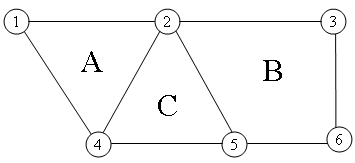Table 6.160 — DRM_Mesh_Face_Table
Property |
Description |
||||||||||||||||||||||||||||||||||||||||||||||||||||||||||||
|---|---|---|---|---|---|---|---|---|---|---|---|---|---|---|---|---|---|---|---|---|---|---|---|---|---|---|---|---|---|---|---|---|---|---|---|---|---|---|---|---|---|---|---|---|---|---|---|---|---|---|---|---|---|---|---|---|---|---|---|---|---|
|
Class |
|
||||||||||||||||||||||||||||||||||||||||||||||||||||||||||||
|
Superclass |
|||||||||||||||||||||||||||||||||||||||||||||||||||||||||||||
|
Subclass |
|
||||||||||||||||||||||||||||||||||||||||||||||||||||||||||||
|
Definition |
An instance of this DRM class specifies a two-dimensional table that defines the face elements of a <DRM Finite Element Mesh> instance in terms of vertex numbers in the ordered <DRM Vertex> component list of the <DRM Finite Element Mesh> instance and, optionally, the topology of the face elements. The first data element specifies, for cell i, j, the index in the ordered <DRM Vertex> list of the <DRM Vertex> representing the jth vertex of the ith mesh face. If the ith mesh face contains less than j vertices, so that j is greater than the number of the last listed vertex of mesh face i, the cell data element contains zero (0). The edges of each mesh face i are implicitly defined by pairing vertex j to vertex j + 1. For a given mesh face element index i and mesh face vertex index j, the (i, j)th cell gives the vertex number that comprises the jth vertex of the ith mesh face. The mesh face vertices are listed (j index) in clockwise order around the outer perimeter of the mesh face, starting and ending with a first vertex. If inner perimeter rings are present, the vertex list along the second axis continues with inner perimeter vertices in counterclockwise order starting and ending with a first vertex on each inner ring. The mesh_face_count field specifies the total number of mesh faces in the <DRM Mesh Face Table> instance. The maximum_vertices_per_face field specifies the maximum number of vertices in any one face element. If the adjacent_face_table_present field is set to TRUE, the given <DRM Finite Element Mesh> instance contains face adjacency information in a separate table termed the adjacent face table, which has the same dimensions as the mesh face table. The values in the adjacent face table are positive integer values that specify face indexes that represent the row in the mesh face table. |
||||||||||||||||||||||||||||||||||||||||||||||||||||||||||||
|
Class diagram |
|||||||||||||||||||||||||||||||||||||||||||||||||||||||||||||
|
Inherited field elements |
|
||||||||||||||||||||||||||||||||||||||||||||||||||||||||||||
|
Field elements |
|
||||||||||||||||||||||||||||||||||||||||||||||||||||||||||||
|
Default field values |
|||||||||||||||||||||||||||||||||||||||||||||||||||||||||||||
Associated to (one-way) (inherited) |
|
||||||||||||||||||||||||||||||||||||||||||||||||||||||||||||
Associated to (one-way) |
|
||||||||||||||||||||||||||||||||||||||||||||||||||||||||||||
Associated by (one-way) (inherited) |
|
||||||||||||||||||||||||||||||||||||||||||||||||||||||||||||
Associated by (one-way) |
|
||||||||||||||||||||||||||||||||||||||||||||||||||||||||||||
Associated with (two-way) (inherited) |
|
||||||||||||||||||||||||||||||||||||||||||||||||||||||||||||
Associated with (two-way) |
|
||||||||||||||||||||||||||||||||||||||||||||||||||||||||||||
Composed of (two-way) (inherited) |
|
||||||||||||||||||||||||||||||||||||||||||||||||||||||||||||
Composed of (two-way) |
|
||||||||||||||||||||||||||||||||||||||||||||||||||||||||||||
Composed of (two-way metadata) (inherited) |
|
||||||||||||||||||||||||||||||||||||||||||||||||||||||||||||
Composed of (two-way metadata) |
|
||||||||||||||||||||||||||||||||||||||||||||||||||||||||||||
Component of (two-way) (inherited) |
|
||||||||||||||||||||||||||||||||||||||||||||||||||||||||||||
Component of (two-way) |
|
||||||||||||||||||||||||||||||||||||||||||||||||||||||||||||
|
Constraints |
|||||||||||||||||||||||||||||||||||||||||||||||||||||||||||||
|
Clarifications |
None. |
||||||||||||||||||||||||||||||||||||||||||||||||||||||||||||
|
Example(s) |
|
||||||||||||||||||||||||||||||||||||||||||||||||||||||||||||
